The Owl in the Rafters is Getting 4 Shades of Desperate
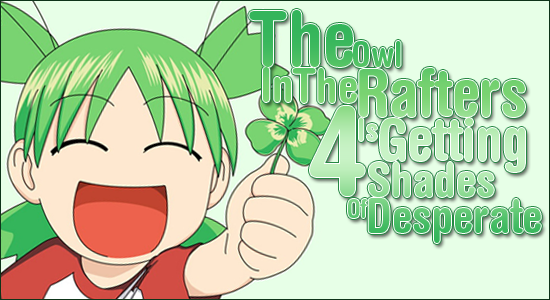
They say a good magician never does the same trick twice, so it’s a good thing I’m no magician or this would somehow be in even worse taste than it already is. I know I’m leaving the Robot Review pt.2: Giant Electric Boogaloo readers hanging here, and I know I’ve already pulled this trick once before (and only just a month ago at that!), and I know it wasn’t even in the best of taste the first time, but I’m going to have to hijack Tempest Wind‘s Anime In-Jokes routine one more time to pump out a quick review. I know, I know, this update can’t get much cheaper; if it were a magic prostitute it’d be turning the same trick twice. So let’s skip the burial and just throw my dignity in a sack and chuck it in the river, because it’s time to explain more obvious observations of painfully plain view patterns in manga, anime, and video games!

This time around, I’m going to go over something you’re more likely to have recognized in a video game, but that still runs rampant all throughout Japanese popular media. I’m sure all of you have noticed at some point or another that Japan just loves to have a team of exactly four mini-bosses who work directly under the big bad villain of the story. Sometimes they’re the generals of an army, sometimes they’re just the four toughest guys around, sometimes they aren’t even technically a team, and sometimes they might not even be people or speaking characters but just four big boss monsters. In any case, they are almost always the last thing standing between the hero and the villain. In some cases they are an arbitrary assortment of four characters, more often they will situate themselves with four distinct elements, generally the classical Western, Earth/Water/Wind/Fire combination.
This comes from one of two sources, or in some cases a combination of both: The Four Heavenly Kings of Buddhism and/or the Four Celestial Animals of Feng Shui.
I should clarify for those unfamiliar that Buddhism is a religion originating in India, which spread throughout mainland Asia as early as the first century CE, and supposedly made its way into Japan via Korea in the mid 500s.  Specifically, Zen Buddhism tends to be the more iconic form recognized by Westerners in relation to Japan and China, and one of the more popular forms in Japan. Zen Buddhism emphasizes the pursuit of the ability to clear one’s mind of all thoughts and feelings via meditation. Presumably entering such a state would make a person like a rock or a plant, unthinking or feeling but in perfect harmony with the world around it: possessing all physical needs without the burden of want, and being a fully functional aspect of nature by allowing it to act upon you without returning resistance. Zen Buddhism however is most notable for its abandonment of the sutra and scripture teachings of its preceding schools of Buddhism and its emphasis instead on personal practice and the teacher-student mentor relationship. But I digress… In any case, the concept of the Four Kings is often a little lost on Western audiences, as it pertains more to the theological side of the more orthodox religion, which we in the West tend to overlook in favor of more eclectic branches like Zen, and the more philosophical aspects of Buddhism in general.
Specifically, Zen Buddhism tends to be the more iconic form recognized by Westerners in relation to Japan and China, and one of the more popular forms in Japan. Zen Buddhism emphasizes the pursuit of the ability to clear one’s mind of all thoughts and feelings via meditation. Presumably entering such a state would make a person like a rock or a plant, unthinking or feeling but in perfect harmony with the world around it: possessing all physical needs without the burden of want, and being a fully functional aspect of nature by allowing it to act upon you without returning resistance. Zen Buddhism however is most notable for its abandonment of the sutra and scripture teachings of its preceding schools of Buddhism and its emphasis instead on personal practice and the teacher-student mentor relationship. But I digress… In any case, the concept of the Four Kings is often a little lost on Western audiences, as it pertains more to the theological side of the more orthodox religion, which we in the West tend to overlook in favor of more eclectic branches like Zen, and the more philosophical aspects of Buddhism in general.
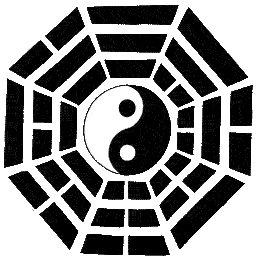 Feng Shui however is not a religious doctrine or teaching at all but a school of ancient Chinese geomancy that was once used (and still is today, though to a much smaller degree) to read the flow of energy in the Earth itself and utilize a proper balance of energy to provide stability and avert calamity. While the concepts of worldly energies at the root of Feng Shui often come across as eclectic and convoluted the actual logic used in recognizing, identifying, and diagnosing signs of movements in the Earth, tides, and weather were all actually quite accurate and reliable. Like Buddhism, Feng Shui found its way to Japan from the asian mainland, and like Buddhism became deeply engrained in the culture and history of Japan.
Feng Shui however is not a religious doctrine or teaching at all but a school of ancient Chinese geomancy that was once used (and still is today, though to a much smaller degree) to read the flow of energy in the Earth itself and utilize a proper balance of energy to provide stability and avert calamity. While the concepts of worldly energies at the root of Feng Shui often come across as eclectic and convoluted the actual logic used in recognizing, identifying, and diagnosing signs of movements in the Earth, tides, and weather were all actually quite accurate and reliable. Like Buddhism, Feng Shui found its way to Japan from the asian mainland, and like Buddhism became deeply engrained in the culture and history of Japan.
 Getting back to the particular icons we’ve got in mind: The Four Heavenly Kings (Bishamontan of the North, a god of war and punisher of evildoers; Zoujouten of the South, a patron of physical growth; Jikokuten of the East the “watcher of the land”; and Koumokuten of the West, “He who sees all”) are four powerful deities said to protect the world, each stationed in one of the four cardinal directions and in East Asian cultures are in turn associated with many of the associated aspects of those directions according to Chinese Wu xing (aka Five Movements or Five Steps). Most notably the name Four Heavenly Kings is referenced directly by title in many instances; In Japanese the title “Shitennou” is very literally, SHI=Four, TEN=Heaven, OU=King(s).
Getting back to the particular icons we’ve got in mind: The Four Heavenly Kings (Bishamontan of the North, a god of war and punisher of evildoers; Zoujouten of the South, a patron of physical growth; Jikokuten of the East the “watcher of the land”; and Koumokuten of the West, “He who sees all”) are four powerful deities said to protect the world, each stationed in one of the four cardinal directions and in East Asian cultures are in turn associated with many of the associated aspects of those directions according to Chinese Wu xing (aka Five Movements or Five Steps). Most notably the name Four Heavenly Kings is referenced directly by title in many instances; In Japanese the title “Shitennou” is very literally, SHI=Four, TEN=Heaven, OU=King(s).
They are also sometimes refered to as Four Generals, which is reference to that fact that the name has been used not only in modern pop culture, but also to refer to samurai retainers and generals of famous real world Japanese historical figures. Four samurai who served under Minamoto no Yorimitsu first took the title as Yorimitsu made famous the military prowess of the Minamoto family; Minamoto no Yoshitsune of the same clan had four famous samurai serving under him who appear in the kabuki play, 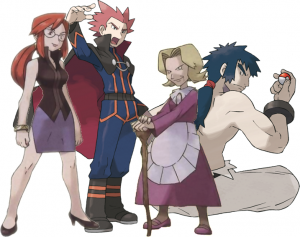 Yoshitsune Senbon Zakura; and finally the four generals of Tokugawa Ieyasu, the founder of the Tokugawa Shogunate, the last Shogunate of Japan before the Meiji Restoration reinstated Imperial rule. This sort of iconography is specifically why the name is used with such frequency to refer to the four strongest characters in a particular group or organization. Perhaps most notable is that this exact title is the Japanese name of the Elite Four in the Pokemon franchise.
Yoshitsune Senbon Zakura; and finally the four generals of Tokugawa Ieyasu, the founder of the Tokugawa Shogunate, the last Shogunate of Japan before the Meiji Restoration reinstated Imperial rule. This sort of iconography is specifically why the name is used with such frequency to refer to the four strongest characters in a particular group or organization. Perhaps most notable is that this exact title is the Japanese name of the Elite Four in the Pokemon franchise.
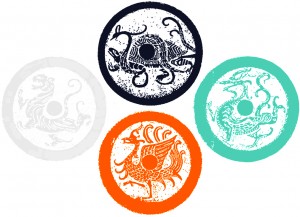 The Four Animals or sometimes Four Beasts of Feng Shui are more commonly seen in iconography, making for much more easily recognizable designs: Genbu, the black tortoise/snake of the North; Suzaku, the vermillion bird of the South; Seiryuu, the azure(blue/green) dragon of the East; and Byakko, the white tiger of the West. Like the Four Kings, the association with four of the cardinal directions carried with it other associations through wu xing. In particular the Four Animals are commonly associated with seasons and elements: Genbu with Winter and water; Suzaku with Summer and fire; Seiryuu with Spring, air and wind; and Byakko with Autumn, metal and lightning. Because of their origins in Feng Shui, they also appear as icons, names, and characters other than villains quite frequently.
The Four Animals or sometimes Four Beasts of Feng Shui are more commonly seen in iconography, making for much more easily recognizable designs: Genbu, the black tortoise/snake of the North; Suzaku, the vermillion bird of the South; Seiryuu, the azure(blue/green) dragon of the East; and Byakko, the white tiger of the West. Like the Four Kings, the association with four of the cardinal directions carried with it other associations through wu xing. In particular the Four Animals are commonly associated with seasons and elements: Genbu with Winter and water; Suzaku with Summer and fire; Seiryuu with Spring, air and wind; and Byakko with Autumn, metal and lightning. Because of their origins in Feng Shui, they also appear as icons, names, and characters other than villains quite frequently.
 Together these two sets of characters have been a staple of anime/manga and videogames for the past 30 years as the go-to format for a quick and easy group of menacing boss characters just below the final boss. Young boys’ action/adventure and combat oriented series most often use these characters as an excuse to hand a big battle to different members of a supporting cast while the main character faces down the leader. Even with just a cursory recollection, I’m sure you can already think of a handful of shows and games that have used this formula -I can even think of a few that used it more than once- and no doubt you’ll bump into it again in the future. By all means, if there is a case of the Four Kings or Four Animals that you’d like to point out, feel free to do so in the comments section below and we’ll see just how many references we can stack up!
Together these two sets of characters have been a staple of anime/manga and videogames for the past 30 years as the go-to format for a quick and easy group of menacing boss characters just below the final boss. Young boys’ action/adventure and combat oriented series most often use these characters as an excuse to hand a big battle to different members of a supporting cast while the main character faces down the leader. Even with just a cursory recollection, I’m sure you can already think of a handful of shows and games that have used this formula -I can even think of a few that used it more than once- and no doubt you’ll bump into it again in the future. By all means, if there is a case of the Four Kings or Four Animals that you’d like to point out, feel free to do so in the comments section below and we’ll see just how many references we can stack up!
As so not to leave those of you waiting on the continuation of my Giant Robot article, hanging: you don’t need to know any details about my personal life, but know that I’m a little busy but I’ll find/make the time between now and August 1st to finish up my crash course in Gundam‘s Universal Century time line. Whether I go on to do a quick abridged run through of everything that came after the UC has yet to be decided.




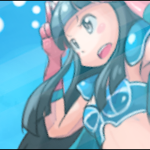

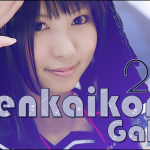



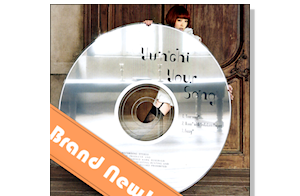





You know, I see the four boss fights in so many things I’ve never made the connection of it solely being Japanese. I mean you can find many things that use the directions as a staple. Just look at the Wiccan religion, something that uses both the four directions and four different elements.
What’s even worse is I knew it was a religious tie from researching Sailor Moon back in the day, but never saw it as just a “Japanese thing”.
It’s so awesome to see someone else with knowledge of The Four Beasts! Kouryuu (K?ry?/?ry?), the Golden/Yellow Dragon of the Center is often forgotten in Japanese retellings of this, and I suppose that other superstitions concerning the number 4 would explain why.
I do have a question, though – Is there a particular reason why the association with the number 4 (shi – death, etc.) hasn’t discouraged the use of the number four. Even if we remove the villainous perspective from games and references, that number is often used in spite of avoidance of use or reference to the number four in practical Japanese culture.